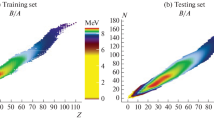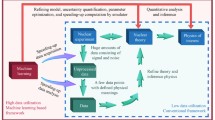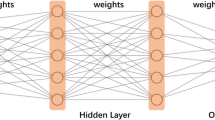Abstract
The global nuclear mass based on the macroscopic–microscopic model was studied by applying a newly designed multi-task learning artificial neural network (MTL-ANN). First, the reported nuclear binding energies of 2095 nuclei \((Z \ge 8,N \ge 8)\) released in the latest Atomic Mass Evaluation AME2020 and the deviations between the fitting result of the liquid drop model (LDM) and data from AME2020 for each nucleus were obtained. To compensate for the deviations and investigate the possible ignored physics in the LDM, the MTL-ANN method was introduced in the model. Compared to the single-task learning (STL) method, this new network has a powerful ability to simultaneously learn multi-nuclear properties, such as the binding energies and single neutron and proton separation energies. Moreover, it is highly effective in reducing the risk of overfitting and achieving better predictions. Consequently, good predictions can be obtained using this nuclear mass model for both the training and validation datasets and for the testing dataset. In detail, the global root mean square (RMS) of the binding energy is effectively reduced from approximately 2.4 MeV of LDM to the current 0.2 MeV, and the RMS of \(S_{\mathrm{n}}\), \(S_{\mathrm{p}}\) can also reach approximately 0.2 MeV. Moreover, compared to STL, for the training and validation sets, 3–9% improvement can be achieved with the binding energy, and 20–30% improvement for \(S_{\mathrm{n}}\), \(S_{\mathrm{p}}\); for the testing sets, the reduction in deviations can even reach 30–40%, which significantly illustrates the advantage of the current MTL.










Similar content being viewed by others
References
T.-L. Zhao, X.-J. Bao, H.-F. Zhang, Improved macroscopic microscopic mass formula. Chin. Phys. C 45(7), 074108 (2021). https://doi.org/10.1088/1674-1137/abfaf2
J.M. Dong, H.F. Zhang, L.J. Wang et al., Density dependence of the symmetry energy probed by \(\beta ^-\) decay energies of odd-A nuclei. Phys. Rev. C 88, 014302 (2013). https://doi.org/10.1103/PhysRevC.88.014302
R. Kanungo, A new view of nuclear shells. Phys. Scr. T152, 014002 (2013). https://doi.org/10.1088/0031-8949/2013/t152/014002
H. Schatz, K.E. Rehm, X-ray binaries. Nucl. Phys. A 777, 601–622 (2006). https://doi.org/10.1016/j.nuclphysa.2005.05.200 (Special Issue on Nuclear Astrophysics)
Z.M. Niu, H.Z. Liang, Nuclear mass predictions based on Bayesian neural network approach with pairing and shell effects. Phys. Lett. B 778, 48–53 (2018). https://doi.org/10.1016/j.physletb.2018.01.002
W.J. Huang, M. Wang, F.G. Kondev et al., The Ame 2020 atomic mass evaluation [I]. Chin. Phys. C 45(3), 030002 (2021). https://doi.org/10.1088/1674-1137/abddb0
W.J. Huang, M. Wang, F.G. Kondev et al., The Ame 2020 atomic mass evaluation [II]. Chin. Phys. C 45(3), 030003 (2021). https://doi.org/10.1088/1674-1137/abddaf
S. Goriely, N. Chamel, J.M. Pearson, Further explorations of Skyrme–Hartree–Fock–Bogoliubov mass formulas. XIII. The 2012 atomic mass evaluation and the symmetry coefficient. Phys. Rev. C 88, 024308 (2013). https://doi.org/10.1103/PhysRevC.88.024308
N. Chamel, S. Goriely, J.M. Pearson, Further explorations of Skyrme–Hartree–Fock–Bogoliubov mass formulas. IX: Constraint of pairing force to \(^1S_{0}\) neutron-matter gap. Nucl. Phys. A 812(1), 72–98 (2008). https://doi.org/10.1016/j.nuclphysa.2008.08.015
P.W. Zhao, Z.P. Li, J.M. Yao et al., New parametrization for the nuclear covariant energy density functional with a point-coupling interaction. Phys. Rev. C 82, 054319 (2010). https://doi.org/10.1103/PhysRevC.82.054319
J.Q. Li, Z.Y. Ma, B.Q. Chen et al., Ground-state and pairing properties of Pr isotopes in relativistic mean-field theory. Phys. Rev. C 65, 064305 (2002). https://doi.org/10.1103/PhysRevC.65.064305
C. Barbero, J.G. Hirsch, A.E. Mariano, Deformation and shell effects in nuclear mass formulas. Nucl. Phys. A 874, 81–97 (2012). https://doi.org/10.1016/j.nuclphysa.2011.11.005
N. Wang, M. Liu, X.Z. Wu, Modification of nuclear mass formula by considering isospin effects. Phys. Rev. C 81, 044322 (2010). https://doi.org/10.1103/PhysRevC.81.044322
N. Wang, Z.Y. Liang, M. Liu et al., Mirror nuclei constraint in nuclear mass formula. Phys. Rev. C 82, 044304 (2010). https://doi.org/10.1103/PhysRevC.82.044304
P. Möller, W.D. Myers, H. Sagawa et al., New finite-range droplet mass model and equation-of-state parameters. Phys. Rev. Lett. 108, 052501 (2012). https://doi.org/10.1103/PhysRevLett.108.052501
P. Möller, A.J. Sierk, T. Ichikawa et al., Nuclear ground-state masses and deformations: FRDM (2012). At. Data Nucl. Data Tables 109–110, 1–204 (2016). https://doi.org/10.1016/j.adt.2015.10.002
J. Duflo, A.P. Zuker, Microscopic mass formulas. Phys. Rev. C 52, R23–R27 (1995). https://doi.org/10.1103/PhysRevC.52.R23
J. Mendoza-Temis, J.G. Hirsch, A.P. Zuker, The anatomy of the simplest Duflo-Zuker mass formula. Nucl. Phys. A 843(1), 14–36 (2010). https://doi.org/10.1016/j.nuclphysa.2010.05.055
G. Royer, M. Guilbaud, A. Onillon, Macro-microscopic mass formulae and nuclear mass predictions. Nucl. Phys. A 847(1), 24–41 (2010). https://doi.org/10.1016/j.nuclphysa.2010.06.014
G. Royer, A. Subercaze, Coefficients of different macroõmicroscopic mass formulae from the AME2012 atomic mass evaluation. Nucl. Phys. A 917, 1–14 (2013). https://doi.org/10.1016/j.nuclphysa.2013.09.003
W.D. Myers, W.J. Swiatecki, Nuclear properties according to the Thomas-Fermi model. Nucl. Phys. A 601(2), 141–167 (1996). https://doi.org/10.1016/0375-9474(95)00509-9
H.F. Zhang. Theoretical studies of nuclear mass formula and nuclear spontaneous fission. Lan Zhou Univercity (CNKI, China, 2015) (in Chinese)
V.M. Strutinsky, Shell effects in nuclear masses and deformation energies. Nucl. Phys. A 95(2), 420–442 (1967). https://doi.org/10.1016/0375-9474(67)90510-6
H.F. Zhang, L.H. Wang, J.P. Yin, P.H. Chen, H.F. Zhang, Performance of the Levenberg–Marquardt neural network approach in nuclear mass prediction. J. Phys. G Nucl. Part. Phys. 44(4), 045110 (2017). https://doi.org/10.1088/1361-6471/aa5d78
A. Bhagwat, Simple nuclear mass formula. Phys. Rev. C (2014). https://doi.org/10.1103/PhysRevC.90.064306
S. Gazula, J.W. Clark, H. Bohr, Learning and prediction of nuclear stability by neural networks. Nucl. Phys. A (1992). https://doi.org/10.1016/0375-9474(92)90191-L
Z.P. Gao, Y.J. Wang, H.L. Lü et al., Machine learning the nuclear mass. Nucl. Sci. Tech. 32, 109 (2021). https://doi.org/10.1007/s41365-021-00956-1
R. Utama, J. Piekarewicz, H.B. Prosper, Nuclear mass predictions for the crustal composition of neutron stars: a Bayesian neural network approach. Phys. Rev. C 93, 014311 (2016). https://doi.org/10.1103/PhysRevC.93.014311
R. Utama, J. Piekarewicz, Refining mass formulas for astrophysical applications: a Bayesian neural network approach. Phys. Rev. C 96, 044308 (2017). https://doi.org/10.1103/PhysRevC.96.044308
R. Utama, W.C. Chen, J. Piekarewicz, Nuclear charge radii: density functional theory meets Bayesian neural networks. J. Phys. G 43, 114002 (2016). https://doi.org/10.1088/0954-3899/43/11/114002
Z.M. Niu, H.Z. Liang, B.H. Sun et al., Predictions of nuclear \(\beta ^-\)decay half-lives with machine learning and their impact on r-process nucleosynthesis. Phys. Rev. C 99, 064307 (2019). https://doi.org/10.1103/PhysRevC.99.064307
H.F. Zhang, J.M. Dong, N.N. Ma et al., An improved nuclear mass formula with a unified prescription for the shell and pairing corrections. Nucl. Phys. A 929, 38–53 (2014). https://doi.org/10.1016/j.nuclphysa.2014.05.019
R. Caruana, Multitask learning. Mach. Learn. 28, 41–75 (1997). https://doi.org/10.1023/A:1007379606734
T.X. Sun, Y.F. Shao, X.N. Li, et al. Learning sparse sharing architectures for multiple tasks. Mach. Learn. https://arxiv.org/abs/1911.05034 (2020)
J. Nocedal, Updating quasi-newton matrices with limited storage. Math. Comput. 35, 773–782 (1980). https://doi.org/10.1090/S0025-5718-1980-0572855-7
Author information
Authors and Affiliations
Contributions
All authors contributed to the study conception and design. Material preparation, data collection, and analysis were performed by Xing-Chen Ming. The first draft of the manuscript was written by Xing-Chen Ming, and all authors commented on previous versions of the manuscript. All authors read and approved the final manuscript.
Corresponding author
Additional information
This work was supported by the National Natural Science Foundation of China (Nos. 1187050492, 12005303, and 12175170).
Rights and permissions
About this article
Cite this article
Ming, XC., Zhang, HF., Xu, RR. et al. Nuclear mass based on the multi-task learning neural network method. NUCL SCI TECH 33, 48 (2022). https://doi.org/10.1007/s41365-022-01031-z
Received:
Revised:
Accepted:
Published:
DOI: https://doi.org/10.1007/s41365-022-01031-z




